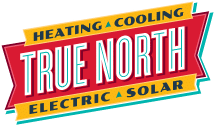On freezing winter days, heating your home will be significantly more expensive than the rest of the year. Heaters require a lot of gas or electricity and, if utilized for an extended period of time, can result in excessive energy costs. So, as a homeowner, you need to ask yourself this question: is my furnace energy efficient? Luckily, there are ways to find out, and when you have professionals like the ones at True North by your side, the process can be quite simple. Follow these top four ways to test the energy efficiency of
We recommend first determining your furnace’s AFUE reading. AFUE stands for Annual Fuel Utilization Rate. Your furnace’s effectiveness at converting fuel into energy can be evaluated by looking at its AFUE rating, whether natural gas, electricity, or propane. Energy efficiency is directly correlated with AFUE rating and it is expressed as a percentage. For example, a furnace with a 95% AFUE rating may produce heat from 95% of the energy it uses. The remaining 5% is likely lost through a PVC drain pipe or chimney flue.
The higher the AFUE rating, the more energy efficient the unit is. The AFUE standard for new furnaces is 78% at the lowest. An ordinary furnace typically has an AFUE rating of 80% to 85%, whereas furnaces with the highest levels of energy efficiency have an AFUE rating of 90% to 97%.
The process of understanding your AFUE rating is simple. All you have to do is take the AFUE rating of your furnace and deduct it from 100. The amount lost for every dollar spent is what’s left. For example, if your furnace had an AFUE rating of 95, you would only lose $0.05 for every $1 spent.
It is important for homeowners to realize that a furnace’s efficiency rating only accounts for a small fraction of the heater’s overall performance. Aside from AFUE rating, dirty ductwork, clogged air filters, and neglected annual furnace maintenance appointments are other factors that can cause your furnace to malfunction.
When you neglect your home furnace’s maintenance, there is a higher chance that it may lose some of its efficiency, which could eventually cause a sharp spike in heating bills.
Confirm the Age of Your Furnace
Your home should be evenly heated throughout by your furnace. However, as your unit ages, it can have trouble uniformly heating your entire home. Regular maintenance is essential.
The average lifespan of a top-rated heater is 20 to 30 years. However, as the furnace reaches the 10 to 15-year mark, corrosion and wear-and-tear could cause its efficiency to start falling sharply. At this time, you should think about replacing your heater to avoid paying additional fees for repairs or using more energy.
You should arrange for a furnace inspection before having your furnace replaced in order to stop carbon monoxide leaks, remove rust and grime that has accumulated, and clean the air filters.
Fortunately, there are now less-expensive heaters on the market that use less energy, making furnace replacement simpler. If your furnace is over 15 years old and starting to experience problems with performance, it is time for an upgrade because your old heater may be using too much energy and costing you an unnecessary amount in your monthly bills. For superior furnace installation services, contact True North.

Study & Compare Your Energy Bills
Energy costs are never constant and may occasionally change due to a variety of causes. However, unexpected and odd changes in your energy bills may be a sign that your heater is having some underlying problems that could be significant. Comparing bills from prior years is a great method to keep track of how your system performs as it ages. It’s important to monitor these expenses so you become immediately aware of an unexpected change and can handle the situation right away.
Your furnace’s structural integrity may have been affected if you notice a big change in your costs from prior years. When comparing your costs, keep in mind any external factors like a cold snap or other elements could also affect your home’s overall efficiency. If you’re unsure what factors have caused the unwanted spike in your monthly bill, we encourage you to contact our experts at True North for our services. We’ll get to the root of the problem and provide professional support, no matter what next steps need to be taken.
Have a Professional Perform a Test for Airtightness
A building’s total air loss during leaks and other potential drafts is measured during an airtight test, paying particular attention to the spaces around windows, doors, and fireplaces. This is typically referred to as uncontrolled ventilation. The airtight test might assist in determining whether the heater is the problem or if it is instead your home’s construction. The majority of the time, building designs will assess airtightness during the preliminary stages of construction to assure compliance.
Your home’s efficiency is increased if its windows are tightly sealed. Since a lot of heat is lost through your home’s roof, the same idea holds true for insulation. Using licensing sticks, you can check the airtightness of your house. This process involves lighting an incense stick and placing it near probable draft-producing sites like electrical outlets, windows, or chimneys.
Air leaks cause the sticks’ tips to glow, which disperses smoke. This enables you to identify the drafts that may be eliminated by caulking joints and gaps, covering vents, and repairing other windows. This improves the efficiency of your heating system as a whole.

As a homeowner, you know what is best for your home so you must choose the best furnace for your house, as well as the best technicians to service it when you need professional help to maintain it. If you feel your present energy expenses are too high or if your furnace has outlived its usefulness, it’s likely time for an upgrade. To preserve your heater’s performance, you should follow regular maintenance procedures and contact the experts for their professional guidance and support.
If you want to have your furnace serviced or replaced, contact True North at (740) 780-5954 today.

